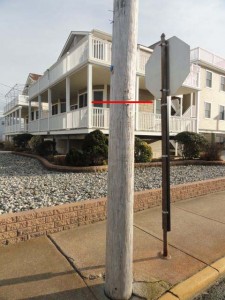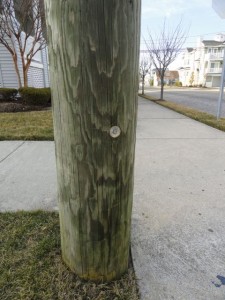About 40 Ocean City property owners crammed into a small library meeting room on Wednesday night to share their nightmares of living on flooded streets.
The people told stories of wading through 35-degree water to return home after moving a car to high ground, of watching small waves crash onto the sides of their houses as trucks “barrel-ass” through floodwaters, and of picking up the mess when it all recedes — railroad ties, cigarette butts, garden mulch from six blocks away and all manner of unidentifiable muck.
The gathering was organized by a subcommittee of the Fairness in Taxes community group and took place at the Ocean City Free Public Library on Feb. 11.

The purpose of the meeting was to rally support to “put some pressure on the city to address our street flooding problems,” according to Eric Sauder, head of the subcommittee.
The people in attendance represented all parts of the city, but most live along or near Haven and Simpson avenues, the corridor that makes up the lowest point of the island. During many high tides, the trough is below sea level, making the task of draining water near impossible.
But the people did not come to talk about big tides and major storms. They came to convey the idea that significant street flooding occurs after a simple summer downpour or even on a sunny day like Wednesday — when tidal waters bubbled up through the storm drain system and covered parts of many intersections.
And they almost universally said the problems seem to have increased in recent years.

“I don’t know what’s going on the last few years,” said Anne Gallagher, who lives at 14th Street and Haven Avenue.
Ed Ritti, who lives at 53rd and Haven, said the water comes up through the asphalt near his home during heavy rain and tidal events, indicating some sort of infrastructure problem. He said he watched a family of kayakers paddle across his front yard during a summer storm in July and waited for a couple days for the water to fully drain.
Residents near 29th Street and Haven Avenue said the installation of check valves (that prevent the back flow of tidal waters through the storm drain system) seemed to improve flooding in that immediate area — a sign that remediation efforts can work.
George Robinson, a resident of West 17th Street, said new check valves did seem to help, but they were of limited value in the lagoon community without corresponding improvements to a network of privately owned bulkheads, some holding back the tides better than others.
_____
Sign up for free daily news updates from Ocean City.
_____
Janet Oberg, who lives on Bay Avenue between 35th and 36th streets, said even Wednesday, a stormless sunny day, the tidal waters were up over the curb in front of her house. She said on many days a year, she can travel down neither Bay Avenue nor 36th Street to leave her home.
Jackie Mittleman, who lives on 23rd Street near Haven Avenue, remembers railroad tracks on Haven and a “swamp” on the other side.
“When I was a kid, it just wasn’t that bad,” she said of the street flooding. “My life is ruled by weather.”
She said she’s constantly monitoring the forecast to know when to move a car to protect it from flood damage. She says she won’t put mulch down because it floats away. Even the nearby handicapped parking spot that her father uses fails to drain after storms.
“It’s a quality of life thing,” she said.
In closing the meeting, Sauder encouraged the residents to attend Thursday night’s City Council meeting in mass to tell their personal stories and ask council about its plan to address street flooding. He also asked them to submit written anecdotes to ocflooding@gmail.com.
Sauder characterized the city as having no long-term plan to remediate street flooding and no plan to seek grants for projects.
In attendance at the meeting, Fourth Ward Councilman Pete Guinosso, who had spoken earlier about his constituents’ frustrations, said nothing about a $5 million FEMA grant for a pumping station to alleviate street flooding in the north end (between Second and Eighth streets, West Avenue and the bay) or about an unsuccessful grant application for the stretch of Haven and Simpson avenues between 29th Street and 34th Street.
He said nothing about a 2012 plan that identifies planned improvements to 71 drainage areas in Ocean City.
The plan, presented two weeks before Superstorm Sandy in October 2012, suggests 31 new tide flex check valves had been installed in the previous three years and 23 replaced.
It identified its overall strategy for addressing street flooding:
- Addition and replacement of check valves that stop rising tidal waters from flowing backwards through storm drainage pipes.
- Rebuilding and heightening bulkheads to prevent tidal waters from flowing directly onto streets.
- Elevating roads.
- Increasing the capacity of storm drainage pipes.
- Cleaning, replacing and re-aligning storm drainage pipes.
The city has a proposed five-year capital plan that commits $29 million alone to road projects that include all recommended drainage improvements within the project areas.
“I don’t want to be a part of vitriol and calling people out,” Ritti said of the plan to make a statement at Thursday’s City Council meeting. “Then you become the crazies, instead of the difference-makers.”





